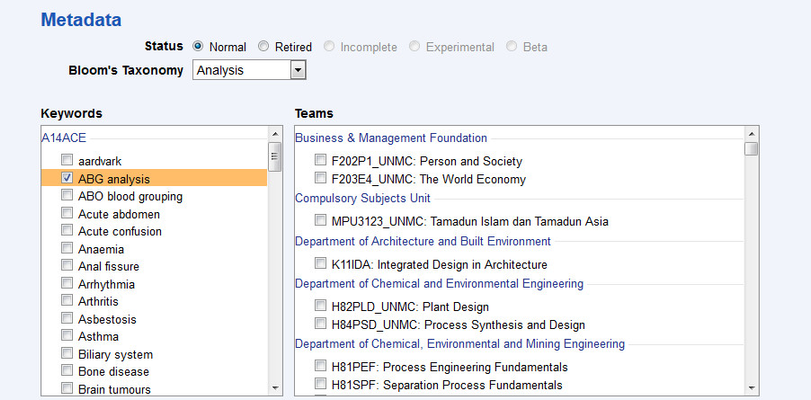
Rogo support many different types of question. Some of these questions may be used in formative assessments, some only in summative assessment, some in both.
The Rogo interface does not preclude question types from being used in any kind of paper, but it would be nonsensical to use certain types inappropriately, for example a Likert question type in a summative examination or an Area in a survey. |
Question Type | Description | Formative | Progressive | Summative | Survey | Offline | OSCE |
|---|---|---|---|---|---|---|---|
| Area | Allows student to specify an area over a background image as their answer. | X | X | X | |||
Numeric answer entry based on questions with random variables. | X | X | X | ||||
Presentation of multiple true/false questions. | X | X | X | X | |||
| Presentation of multiple scenarios sharing a common set of answer options | X | X | X | ||||
| A paragraph of text with blanks inserted which the student completes | X | X | X | ||||
Student has to click on the correct part of an image. Multiple parts can be presented in a single question. | X | X | X | ||||
Not a question as such – this provides information to the student to assist them with the rest of the questions/paper. | X | X | X | X | |||
| Keyword-Based | Selects a random question based purely on keyword tags | X | |||||
Student has to drag labels to the correct placeholders on top of a background image. | X | X | X | ||||
Psychometric scale for use on surveys. | X | X | |||||
| Match questions to answers in a matrix presentation | X | X | X | X | |||
Pick one correct option from many. | X | X | X | X | X | ||
Pick several correct options from many. | X | X | X | X | |||
| Textbox | Free form text answers | X | X | X | X | ||
| Random Question Block | Selects a question randomly from a predefined pool of questions | X | |||||
| Ranking | Students select a number of choices in order | X | X | X | X | ||
| Script Concordance Test | The Script Concordance Test is a tool intended to assess mental processes in medical practice | X | X | X | |||
| True/False | True/false answer to a question. | X | X | X | X |
Questions follow a common lifecycle throughout all exams.

The phases of this life-cycle also share commonalities.
When creating a new question, there are certain features in common to all.
The preamble consists of several fields that must be supplied:

The Scenario and Lead-in fields are rich text which means that they support images, so the Change Media button is somewhat redundant.
The fields that follow immediately are specific to the question type only and will not be covered here.
This is the last section on the question screen. You use this section to specify several aspects of the question:

The final section of the form has buttons which add the question to the bank or the bank and paper.